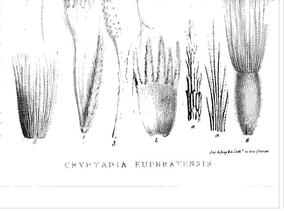You are here
Taxonomy
Gymnarrhena micrantha
Nomenclature
-
Family: CompositaeGenus: Gymnarrhena
SUMMARY
Taxonomy
[synonomy is available at the end of this section] [available protologues are attached as images; not all protologues are available at this time]
Tribe Gymnarrheneae Panero & VA Funk (subfamily Gymnarrhenoideae Panero & VA Funk).
Gymnarrhena Desfontaines, Mémoires du Museum d’histoire naturelle. Paris, 4: 1. (1818), T.: G. micrantha Desfontaines. Currently this genus has only one species.
Type: Gymnarrhena micrantha Desfontaines, Memoires du Museum d’histoire naturelle, Paris. iv (1818) 1. t. 1
Synonym
Gymnarrhena balansae Coss. & Durieu ex Coss. & Kralik, Bulletin de la Societe Botanique de France 4: 180. (1857) [currently in synonomy with G. micrantha Desf.]
Annual amphicarpic herbs with a prostrate rosette, no more than a few cm high; no reports of milky sap. Leaves simple, forming a dense rosette, sessile, smooth, narrowly lanceolate to narrowly ovate, apex narrowly acute to attenuate, margins denticulate, base truncate, surfaces smooth and glabrous. Subterranean heads homogamous, female, cleistogamous, surrounded by the leaf bases; florets enclosed in involucral bracts, corolla vestigial; achenes relatively large, laterally flattened, blackish, sparsely hairy, remaining below the soil surface on the dead parent plant; pappus absent, vestigial, or of short, basally flattened, somewhat scale-like bristles. Aerial heads congested in the center of the leaf rosette, heterogamous, disciform; involucral bracts imbricate in several series, chartaceous, whitish, acute; receptacle convex, marginally bristly; with a few rows of chartaceous phyllaries. Functionally staminate florets in small groups, loosely connected on very short pedicels, interspersed among the small pistillate florets, corollas small 3-4 lobed, whitish; stamens 3-4, anthers calcarate, ecaudate, without apical appendage. Pistillate florets solitary, each enclosed in a prominent, stiff, white and green bract; corolla filiform, style arms long, with rounded apices. Achenes of functionally staminate florets vestigial, pappus of a few irregularly lacerate scales or absent; achenes of pistilate florets numerous, tiny, ovoid, ciliate, villous, with long twin hairs, cell walls thin, pappus of long-lanceolate, ciliate, acutely acuminate scales.
A second species G. balansae Cross. & Durieu was based on two collections from near the coast in Tunisia and Algeria and they appear to be somewhat different from the collections from the Middle East and further inland in Algeria. However, a more detailed study will have to be made to determine the validity of this taxon.
Gymnarrhena has been collected from North Africa to the Middle East. It is a winter annual and its flowering depends on the rain but usually takes place in March and April (May). According to Gutterman (1989) the life span of the plants is around 67 days out-of-doors (full sun) where it produces both types of heads and 140 days in the greenhouse (8 hours of light) where it produced only aerial heads.
Remaining Synonomy
Cryptadia Lindley ex Endlicher, Genera Plantarum secundum ordines naturales…. By Stephan L. Endlicher. Suppl. 1: 1381. Feb-Mar 1841. T.: non designatus
Cryptadia euphratensis Lindley in Chesney, Narrative of the Euphrates Expedition carried on by Order of the British Government during the years 1835-1837. (1868) t. ad p. 441.
Frankia Steudel ex Steudel, Nomenclator botanicus: numerans ordine alphabetico nomina atque synonyma, tum generica tum specifica, et a Linnaeo et recentioribus de re botanica scriptoribus plantis phanerogamis imposita /auctore Ernesto Steudel. ed. 2. 1: 646, (1840); nom. inval.
Frankia schimperi Steud. Nomencl. Bot. [Steudel], ed. 2. 1: 646, (1840); nom. inval. in syn.






